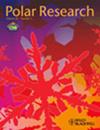The challenges of a small population exposed to multiple anthropogenic stressors and a changing climate: the St. Lawrence Estuary beluga
IF 1.3
4区 地球科学
Q3 ECOLOGY
引用次数: 12
Abstract
The beluga (Dephinapterus leucas) has a discontinuous circumpolar distribution in the Arctic and Subarctic regions, with eight populations occurring in Canadian waters (Stewart & Stewart 1989; COSEWIC 2016). The lack of a dorsal fin and a relatively thick dermis (5–12 mm) make the species particularly well adapted to environments with seasonal and extensive ice cover. The population in the SLE, Canada, is at the southern limit of the species’ global distribution and probably established itself thereafter the Wisconsin glaciation (Harington 1977, 2008). The beluga persistence in the SLE is probably largely due to the combination of an extensive and seasonal seaice cover and the cold and productive environmental conditions that are maintained in this region in part from the influx and upwelling of Arctic waters of the Labrador Current (El-Sabh & Silverberg 1990). The SLE beluga, like several other populations, undertakes seasonal movements, but its extent appears limited to a few tens or hundreds of kilometres (Mosnier et al. 2010). The core of its distribution remains in the SLE year-round, but an unknown and likely variable proportion of the population moves eastward each fall to winter in the western Gulf of St. Lawrence (Fig. 1). While immigration from other populations might have been notable a century ago (Vladykov 1944), the SLE beluga population now has the lowest haplotype diversity of all beluga populations and shares none with other populations (Postma 2017; Skovring et al. 2019). Abstract一个小种群暴露于多种人为压力和气候变化的挑战:圣劳伦斯河口白鲸
白鲸(Dephinapterus leucas)在北极和亚北极地区有不连续的环极分布,在加拿大水域有8个种群(Stewart & Stewart 1989;COSEWIC 2016)中。缺乏背鳍和相对较厚的真皮(5-12毫米)使该物种特别适应季节性和广泛冰盖的环境。加拿大SLE的种群处于该物种全球分布的南部极限,可能是在威斯康辛冰期之后建立起来的(Harington 1977,2008)。白鲸在SLE的持续存在可能主要是由于广泛的季节性海冰覆盖和该地区维持的寒冷和多产的环境条件的结合,部分原因是拉布拉多洋流的北极水域的涌入和上涌(El-Sabh & Silverberg 1990)。SLE白鲸和其他几个种群一样,也会进行季节性迁徙,但其范围似乎仅限于几十或几百公里(Mosnier et al. 2010)。其分布的核心全年仍在SLE,但每年秋冬,在圣劳伦斯湾西部,未知且可能可变的种群比例向东移动(图1)。尽管一个世纪前其他种群的移民可能很明显(Vladykov 1944), SLE白鲸种群现在的单倍型多样性是所有白鲸种群中最低的,与其他种群没有任何共享(Postma 2017;Skovring et al. 2019)。摘要
本文章由计算机程序翻译,如有差异,请以英文原文为准。
求助全文
约1分钟内获得全文
求助全文
来源期刊

Polar Research
地学-地球科学综合
CiteScore
3.20
自引率
5.30%
发文量
22
审稿时长
>12 weeks
期刊介绍:
Since 1982, Polar Research has been the international, peer-reviewed journal of the Norwegian Polar Institute, Norway''s central institution for research, environmental monitoring and mapping of the polar regions. Aiming to promote the exchange of scientific knowledge about the Arctic and Antarctic across disciplinary boundaries, Polar Research serves an international community of researchers and managers. As an open-access journal, Polar Research makes its contents freely available to the general public.
Original primary research papers comprise the mainstay of Polar Research. Review articles, brief research notes, letters to the editor and book reviews are also included. Special issues are published from time to time.
The scope of Polar Research encompasses research in all scientific disciplines relevant to the polar regions. These include, but are not limited to, the subfields of biology, ecology, geology, oceanography, glaciology and atmospheric science. Submissions from the social sciences and those focusing on polar management and policy issues are welcome. Contributions about Antarctica are particularly encouraged.
 求助内容:
求助内容: 应助结果提醒方式:
应助结果提醒方式:


